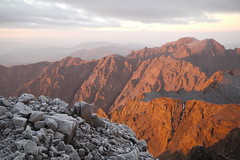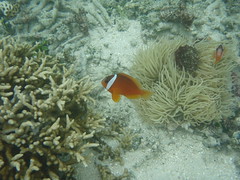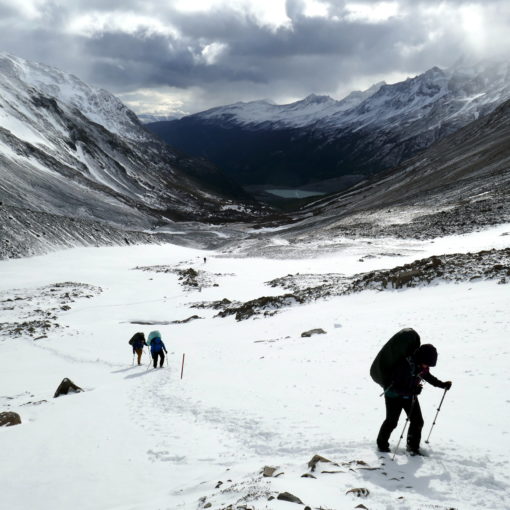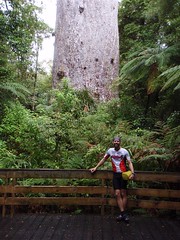Welcome to the second post detailing some of the awesome experiences Deanna and I had in Morocco. This time, I’ll take you a bit off the beaten path, and talk about two particularly awesome experiences. Namely, the high of trekking and climbing in the High Atlas mountains, including sumitting the highest peak in North Africa, as well as the lows of heading to the depths of the deepest caves in North Africa, the Friouato Cave system. For Deanna, these were particularly fun, as she had never climbed a mountain before or gone cave exploring. In another post, I’ll visit a first for BOTH of us, but this time, it’s all about Deanna’s firsts. If you check into flickr, you’ll eventually find pictures from both, but for now, only the Atlas Mountain pics are up. Eventually, they’ll all be in the collection though. For now, I’ll just give you a bit of the blow by blow in written words. Enjoy!
It’s no secret that I love the mountains. I’ve now seen some pretty incredible ones in several continents. This includes the Rocky Mountains of Canada, a few different peaks (including the mighty Aconagua in South America) on travels in Argentina and Peru, the Alps of Switzerland, and the high mountains in New Zealand. Every time I spend any time in the mountains either alone or with others, I get a great sense of my place in the world. I love the clean air, the majesty and ruggedness of the environment, and the feeling of being basically a speck of dirt on this great planet we inhabit. The feeling is compounded even further after being subjected to the chaos of busy cities. This is exactly the circumstances in which we started our high Atlas trekking. We’d just spent a night in Casablanca and a day and night in Marrakech, which is the very definition of chaotic in the centre of the Medina.
We awoke early on a Monday to be picked up by a taxi drive who shuttled us from Marrakech to the village of Imlil, nestled in the foothills of the High Atlas. Our ultimate objective was to summit Mount Toubkal, which at 4,167m is not the tallest mountain I’ve ever climbed, but the highest of north Africa. We’d be spending 3 days and 2 nights trekking. We had a guide, a muleteer, a cook, and at the last minute, learned 2 other trekkers (from Scotland) would be joining us. The weather? Absolutely amazing. Bright, sunny, and warm all 3 days. So no need to dwell on that. Obviously we’d have done it no matter what the weather, but no rain was certainly a treat compared to my mountain experiences last time in Africa at Kilimanjaro and Mount Meru.
Our first day wasn’t too bad. We spent probably 4-5 hours total trekking, heading gradually up the valleys and around some of the smaller mountains to get to our eventual ‘refuge’ for the first night. Along the way, we stopped for our lunch, which as per usual on these types of trek, was amazing. Fresh prepared food with fresh ingredients. And of course, they always give you way too much food. We were getting to know our guide and the two other crew on the trip, and although there was a slight language barrier, we all got along well. Day 1 was definitely impressive for the sights, and knowing that the best was yet to come put me in high spirits. The High Atlas are impressive not only for their rugged beauty, but the fact that they completely surround you. Very rocky and barren, with many criss-crossing trails in some spots. The area has been used for a very long time for grazing sheep and goats, and has even played a strong part in the history of the country as a stronghold for keeping enemies at bay.
Instead of tents, we were lucky enough to be able to use a refuge for sleeping. Basically, sleeping mats in an open room with blankets. With no electricity and early sunset, our night ended pretty early. I grabbed an ‘alpine shower’ in a drip of cold water, and tried snapping pictures in the light of a near full moon, but still hit the hay around 9am. Good thing too, as our next morning started bright and early. This day, we’d have at least 6 hours solid trekking. It started kinda chilly, but passing waterfalls and having the sun rise and light up the mountains around us made it a joy. We also had a very steep switchback climb up a scree valley to keep us on our toes. Deanna and I had struck out on our own and were between the two helpers, while our guide was farther back with the another trekker. It was nice to just be totally on our own out there. The sights of day 2 were even more impressive than day 1, and I was clearly starting to fall in love with the Atlas mountains. Definitely high on my list of favourite treks. Once again, we stopped for lunch, and our spot had a perfect view of our conquest, Mount Toubkal, looming across a valley from us high above. We could also see our camp for the night, further down a valley. Sadly, we’d be descending to it, only to have to climb back out for the summit.
Once at the Toubkal Refuge, we talked about summit plans. Most climbers start at first light, get there late morning, then head back down valley. However, I convinced the team that we should head out around 2am in order to be at the summit for sunrise. This was met with some resistance, but I’m quite sure if you ask everyone now, they’ll agree it was the right call. The climb up, although in the dead of night, was amply lit by the light of the moon. We had the trail completely to ourselves. It wasn’t an easy climb, but we’d given ourselves the right amount of time. We actually put climbed the last bit before the sun even rose up. There was early morning glow, but no sun yet. The summit? Well, we had that completely to ourselves as well. It was absolutely spectacular in all respects. Of course, it was also quite cold, so we didn’t stay super long, but at least 20 minutes. Eventually I’ll have some video up.
Our return path was also different from most people. I’d also convinced us to take the ‘south col’ route down. Pretty treacherous at the top, and then heads down another scree valley to meet the main trail far below. It is also the final resting place of a crashed airplane from the 1970s. The debris field was quite large, with interesting bits of twisted metal all around. It was only 8am as we were heading down the last bits, but we’d already put in a solid day of hard climbing. However, we stil had another 6 or so hours of trekking to get us all the way back to Imlil. We were all a bit tired, but just plodded on, one foot in front of the other. Deanna and I were the only trekkers in our group to actuall hike the whole thing, and we were pretty strong. I was very proud of Deanna in the mountains, and can’t wait for the day we head to Nepal to do some serious mountain trekking :-). Lunch on this day was in a holy village in the valley heading back to Imlil. It was a great time to take a little crash and lay in the sun. Just the re-charge we needed to take us to the end, and in time to watch one of our mules go a little crazy! Ask me in person some time about that.
With the mountains out of the way, I now take you all the way to the northeast of the country, the Friouato Caves, reputed to be the deepest in North Africa. To quote one of our guidebooks “The sense of descending into the entrails of the earth is exhilarating.” We can attest to that. However, this was no multi-day affair. We basically made this a day trip from Taza. The trip to and from was just as exciting too. We left our hotel in the morning, used a grand taxi to get us there, then planned on hitching a ride back to Taza to catch a train to Fes. We didn’t realize that getting a ride back would prove challenging. But it was. The caves are NOT on the beaten path, so walking along the road we saw almost no cars, and we were 27km or so from town. One car going the other way even stopped and gave us fruit as we walked, which was super cool. Eventually, we DID get picked up (after several km trek in the hot sun). This fellow was exactly what I hoped. His car was actually barely running. He didn’t want to stop, as the car might not start again, but since it was mostly downhill, he took the chance. We had great conversations on the ride back to town, and he refused payment, offered advice, and even pointed out restoration work being carried out by UNESCO in the area. All this contributed to Deanna’s decision that Taza was probably her favourite place. A quick filling lunch, with more friendly locals, and we caught our train to Fes.
But what about the caves you’re wondering? In a single word, cool. Not breathtaking or amazing, but cool. I’ve had the good fortune of seeing a couple other cave systems now, the best being the Lucky Strike caves in New Zealand, and the level of care they take inpreserving those sort of put Friouato to shame. The public access to the Friouato caves is well worn with foot traffic, and there is a fair bit of just mud. Also, many of the stalactites and stalagmites have been damaged, which was sad to see. Kind of how you feel when you see someone break a piece of coral reef that you know took decades to grow. In spite of that though, there were some amazing sections of curtain stalactites, water pools, and just general grandeur to take in. You have the option of just going to the mouth of the cave for one price, or you can pay to have a guide walk you 3km into the cave, then retrace the steps. Obviously we got the guide. We are unlikely to ever return, so spending the extra money was worth it!
I will say this for these caves. They are massive. Compared to all others I’ve been in, these ones boggled the mind. For the entire 3kms, we were in pretty wide open cathedral-type spaces. In other caving trips, there was lots of crawling through little openings, and lots of narrow passages. Not here! Just wide open spaces. Of complete darkness. We’d shown up pretty early in the morning, so once again, we had the place to ourselves. In fact, we sort of woke up both the cafe / shop owner and the guide. We basically made them open up the caves for us. Not sure how they liked that. However, our books said it was open at 8:30, and we showed up at 9am, so we didn’t feel too bad! Overall, I’d say Deanna was also pretty impressed with this experience. She had no idea what to expect, and I think it’s safe to say that it blew her non-expectations out of the water. Just the descent into the cave system entry was really cool. Over 500 steps carved in rock from the top to the bottom, created in the 1930’s by French spelio-dudes. Unfortunately, it was very difficult to take any pictures that would do it justice.
So there you have it. The highest highs and lowest lows of Morocco for us. Next up in the series will be a story about a true first for both of us, and another of the highlights of the trip. Till then, hope you all enjoyed this post, and check back for the next installment!







